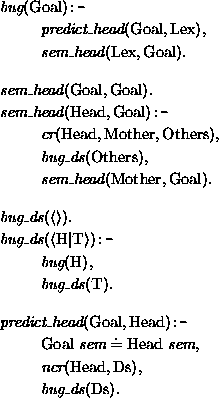On the other hand, rules without a head (such as lexical entries) are called non-chain-rules and are represented as
Clauses which have a daughter with identical semantics as the mother node, are called chain-rules, and are, for the purpose of the generation meta-interpreter, represented as:
![]()
On the other hand, rules without a head (such as lexical entries) are
called non-chain-rules and are represented as
![]()
The following meta-interpreter in figure 5.8 defines a simple instantiation of the semantic-head-driven processing strategy. In chapter 3 several improvements and variations of this strategy are discussed.
 |
The semantic-head-driven strategy is compared with the top-down oriented approaches of [108] and [17], and the chart-based approach of [83]. Semantic-head-driven generation is more general than those top-down oriented approaches as it handles certain linguistically motivated left-recursive analyses of subcategorization. On the other hand semantic-head-driven generation must be favored over Shieber's chart-based generator because it allows certain non-compositional analyses, such as those proposed for idiomatic constructions.
An important problem for semantic-head-driven generation are linguistic analyses which are based on a threading implementation of head-movement. I provide an analysis of verb-second in Dutch along those lines, which is problematic for semantic-head-driven generation (because it violates the assumptions about the construction of the semantic structures mentioned above). A further problem for semantic-head-driven generation is exemplified by an analysis of English raising-to-object constructions.
Although I do provide some ad-hoc solutions to these problems, it can be argued that a more general solution is available only, if we allow grammars in which phrases can be built with other operations than concatenation. For example, raising-to-object constructions can be analyzed using Bach's `wrap' mechanism. The resulting analysis is not problematic for semantic-head-driven generation. On the other hand, such more powerful operations on strings lead to an increased burden on the parser.